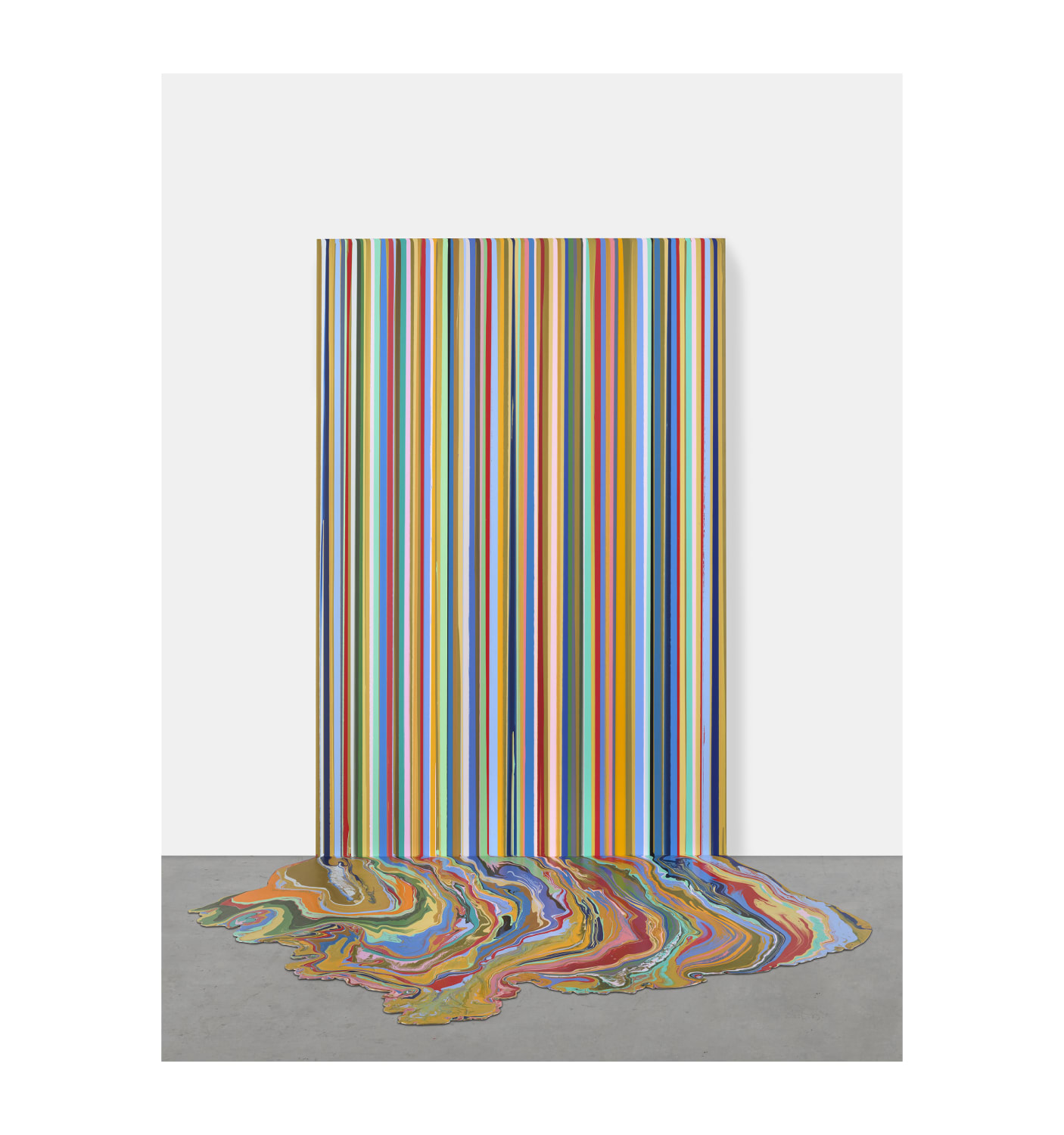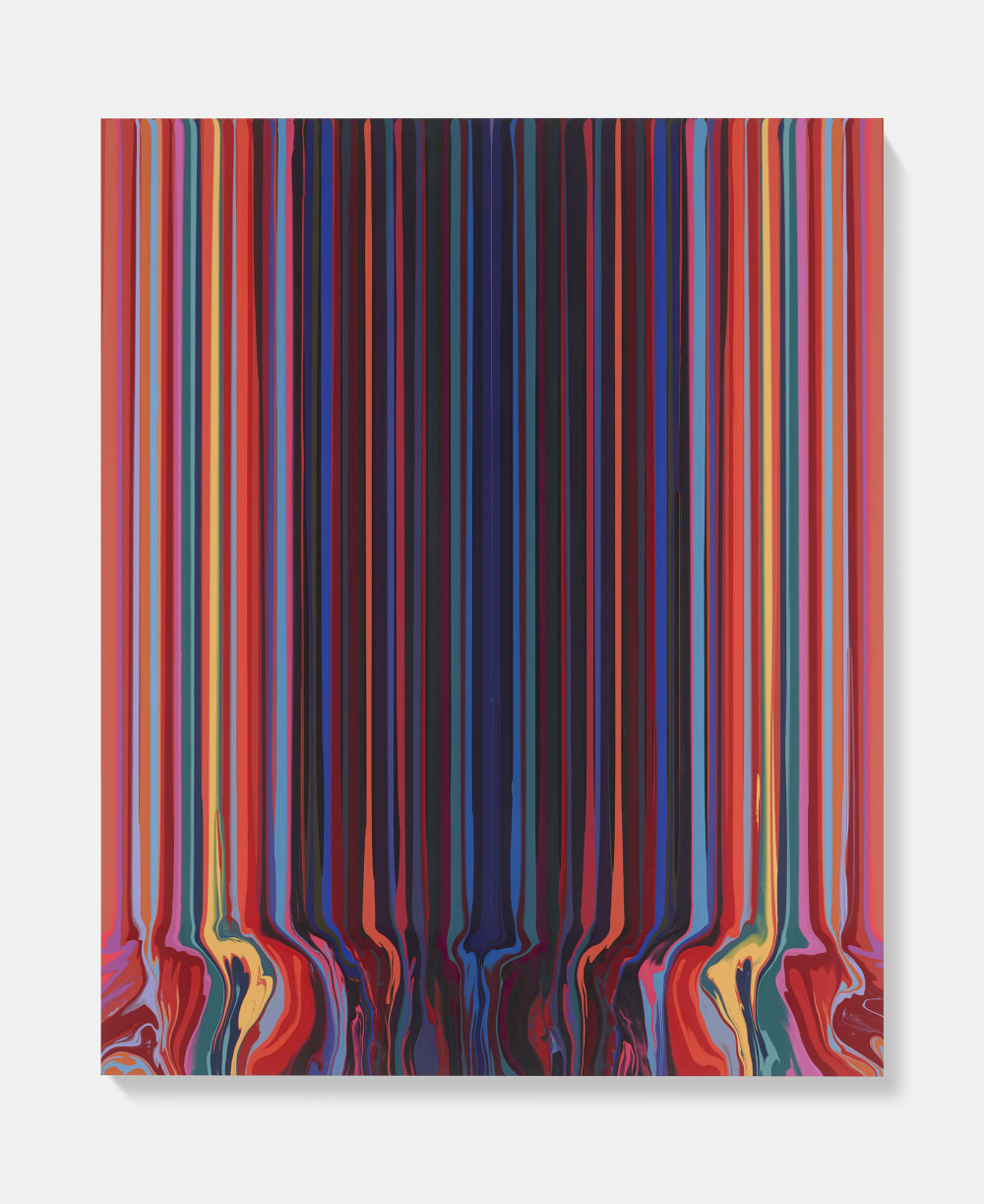Tides: Kasmin Gallery
Ian Davenport, Tides, Kasmin
Ian Davenport relishes the intense pull of gravity. Throughout his career, the British artist has encouraged paint to flow and drip down the length of his vast canvases, often rushing to the floor in lively swirls. For ‘Tides’, a solo exhibition of new paintings and works on paper at Kasmin, he continues to make use of gravity while channeling other energies that shape our lived environments. These dynamic paintings are suggestive of currents of air and tidal pulses, which can be recognized for their powerful impact on the planet and felt by the body. Davenport embraces the movement and dynamism of such forces: fissures and deep undulations erupt from his orderly lines; tiny bubbles of air form at the meeting point of his vertical runs; paint comes alive in electrifying whirlpools, mirroring bubbling lakes of molten lava.
‘White Tide’, a central piece within the exhibition, features Davenport’s characteristically bold strokes, in a series of reds, purples, greens, blues, whites and metallics. The work’s thin, vibrant stripes were formed by a series of watering cans held above the canvas, containing wet paint that tumbled to the bottom before merging and drying in a sweeping reservoir on the ground. Like many of his works, the sculptural material in ‘White Tide’ can be seen in direct relation to gravity, playing with and making visible this natural power.
Davenport shifts the energetic focus in other paintings. In works such as ‘Run’ and ‘Small Tide’, it is as though the rich liquid puddles have been drawn back up the canvas by a second magnetic force, evoking the to-and-fro of waves. Specs of color gather around the tide-like frontier where clean lines meet the more chaotic mass of pooling paint. In ‘Large Fra’ and ‘Icon No 3’, a polychromatic accumulation gathers near the bottom though doesn’t spill all the way, as if it has been frozen and held before hitting the ground. The marbling at the base of ‘Small Blue and Gold’ is hitched up higher to the right than the left of the work, giving the impression of a gravitational pull coming diagonally across the canvas. ‘Centred’ and ‘The Bottom is the Top’ feature mirrored colors and tiny quirks in Davenport’s otherwise neat scores of paint; within these pieces, the viewer might feel pulled into the middle of the work, following the hypnotic flows as they move towards a central point.
In the setup of these paintings, the artist meticulously plans colour palettes and sequences. Once the process begins, much is then left to chance. Therefore, they offer a fine balance between controlled and unplanned movement. Likewise, the natural forces that inspire this body of work simultaneously exude calm and chaos. The tidal pulls on the sea, for example, are capable of both serene rhythm and ferocity; the wind can offer a gentle tingle to the skin on a summer day, or a violent whirl at gale force, rattling giant trees and glass windows. Davenport recalls a sense of peace and homeliness in the sea, in particular, reflecting upon his early childhood in Northern Ireland. As he learned to swim in the island’s surrounding waters, the artist experienced the invigorating appeal of both the pulsing tides and bracing air. In relation to these forces, we become more aware of our own physical presence; in Davenport’s works, it is the paint that makes us conscious of the forces themselves.
A series of works on paper in ‘Tides’ represent a return for the artist. Davenport has recently exhibited a series of rediscovered pieces from his archive, with some revealing an early interest in the impact of gravity or air blasted from an electric fan on wet paint. Following this, ‘Tides’ includes a series of works on paper which eschew the controlled drips and lines of his larger works and instead present explosive splatters built up in thick layers. These pieces contain a sumptuous combustion of color and form, loaded with a multitude of fine drips and dashes, which look as though they could be falling in on themselves or detonating outwards. They suggest a highly physical dynamic between the artist and the work, as he throws paint at its surface. Unlike his puddling paintings, these pieces contain frenetic bundles of energy within their four edges, evoking the more spirited forces at play in the natural world, which we may try to command and bend to our will, but that ultimately retain their own compelling might.
In keeping with the artist’s ongoing fascination with the palettes of art historical paintings, many of the formations in ‘Tides’ have been inspired by masterpieces of other artists. In their finished form, Davenport’s canvases conjure the emotional resonance of these original paintings while refining their imagery to elemental compositions. ‘Large Fra’ and ‘Angelico’ have both been informed by the cobalt blue, deep greens and reds in the early Renaissance artist’s ‘Coronation of the Virgin’ (c. 1432). Davenport has also started working with metallic paint, in reference to the abundant gold leaf that covers Angelico’s masterpiece. These glistening lines add a further dimension to his poured works, with light reflecting from the surface as electric stripes leap forward from those around them. The artist has embraced a darker palette for a number of works in ‘Tides’, inspired in part by the play between shade and light in Caravaggio’s paintings that Davenport explored in Florence while considering the looming shadow of the pandemic. In contrast with the direct vibrancy of works like ‘Run’, pieces such as ‘Adoration’ and ‘Black Redeemer’ contain deep tones that seem to suck the viewer into the void.
Through moments of brilliant light and intense darkness, Davenport’s works retain a pulsing, musical rhythm. The bold, assertive lines of ‘Gold Centre’ could be seen to mirror the power chords of a guitar; while the thin stripes of ‘Icon No 2’ and ‘Redeem’ dance wildly in front of the eyes, suggesting sharp staccato sounds. The works are not strictly representative, but a source of energy in and of themselves. Whether channeling the rhythmic pulse of the sea or the jovial beats of music, Davenport gives animated form to the vital elements that enliven our world.
Words by Emily Steer




